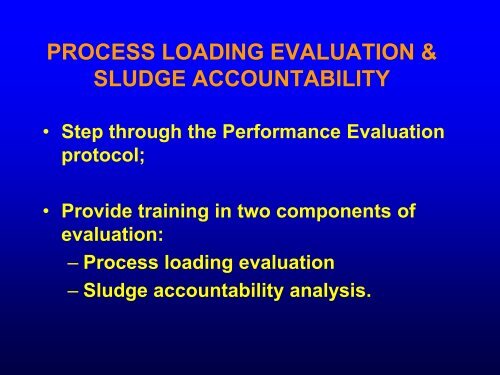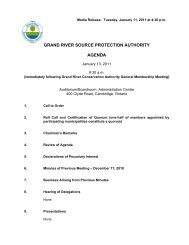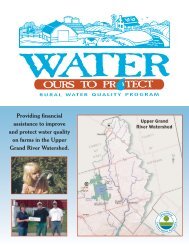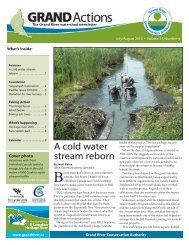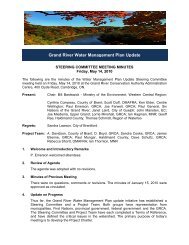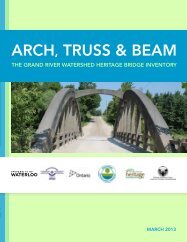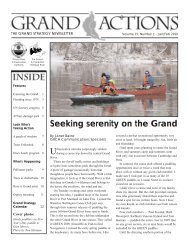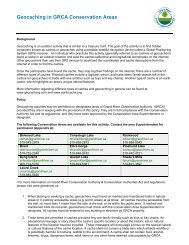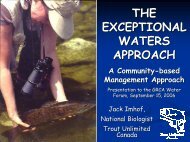Workshop #1 Part 2 - Grand River Conservation Authority
Workshop #1 Part 2 - Grand River Conservation Authority
Workshop #1 Part 2 - Grand River Conservation Authority
You also want an ePaper? Increase the reach of your titles
YUMPU automatically turns print PDFs into web optimized ePapers that Google loves.
PROCESS LOADING EVALUATION &<br />
SLUDGE ACCOUNTABILITY<br />
• Step through the Performance Evaluation<br />
protocol;<br />
• Provide training in two components of<br />
evaluation:<br />
– Process loading evaluation<br />
– Sludge accountability analysis.
Two-Step Protocol<br />
COMPOSITE CORRECTION PROGRAM<br />
STEP 1<br />
COMPREHENSIVE PERFORMANCE<br />
EVALUATION (CPE)<br />
STEP 2<br />
COMPREHENSIVE TECHNICAL<br />
ASSISTANCE (CTA)
CPE OUTCOME<br />
• Identify, Classify, & Prioritize Major Performance<br />
Limiting Factors (5-8)<br />
• Classifies Design of Plant:<br />
• Type I (Adequate)<br />
• Type II (Marginal)<br />
• Type III (Inadequate)<br />
• Determine Suitability for Follow-up Technical<br />
Assistance<br />
• Findings presented at end of on-site activities;<br />
•Recommendations NOT Provided
CPE EVALUATORS<br />
• Design assessment experience<br />
• Operations experience<br />
• “Interview” skills i.e. tact;<br />
• Freedom/authority to address<br />
admin/management issues
Scheduling<br />
• Initial Set-up Activities<br />
• On-Site Evaluation<br />
‣ minimum 2 evaluators<br />
‣ typically 5 continuous working days<br />
• Follow-up CPE Report
CPE As Skills Development<br />
• Initial half day workshop<br />
• <strong>Part</strong>icipants support trainers:<br />
‣ “arms-length” from day-to-day operation<br />
‣ Maximum of 5-6 participants<br />
‣ Commitment for entire week;<br />
‣ Initially, trainers responsible for outcome;<br />
‣ Allow time for debriefing<br />
‣ CPE Exit Briefing is joint responsibility.<br />
• <strong>Part</strong>icipants debrief training experience.
CPE:<br />
REFERENCES<br />
• US EPA Handbook<br />
• Ontario CCP Handbook
Other:<br />
RESOURCES (con’t)<br />
Plant Name:<br />
Date Prepared:<br />
Prepared By:<br />
9-Nov-09<br />
Phil Wilson<br />
Step <strong>#1</strong>: Determine SOTR & alpha (based on system type)<br />
• ISCO Flow Measurement Handbook<br />
INPUT <strong>#1</strong>: OUTPUT <strong>#1</strong>:<br />
Fine bubble, total floor<br />
• Metcalf & Eddy<br />
ά<br />
• US EPA Design Manual<br />
INPUT #2:<br />
On Phosphorus<br />
OUTPUT<br />
Removal<br />
#2:<br />
Temp 20 o C K 0.847<br />
Diffuser Depth 14.4 feet AOTR/SOTR 0.42<br />
• Excel spreadsheet templates<br />
System SOTR 6.25 lb O 2 /wire.HP.h<br />
0.5 [no units]<br />
Mixed Liquor D.O. 2.0 mg/L AOTR 2.65 lb O 2 /wire.HP.h<br />
Elev<br />
572 feet<br />
Dunville WPCP<br />
Step #2: Determine AOTR (based on temperature, diffuser depth, D.O. and elevation)<br />
Figure 1: Dunville WPCP PPG Step#3: Determine OTC (based on HP available)<br />
Total HP 180 Criteria HP OTC 3,900 kg O 2 /d<br />
Unit Process (rating criteria) Size Units Stnd Max Units Base Increment Max<br />
Aeration HRT (6 h) m 3 h 11,600<br />
BOD Loading (0.5 kg BOD5/m 3 /d) m 3 kgBOD5/m 3 /d 7,792 2,640 10,432<br />
Step#4: Determine Oxygen Demand At Peak Monthly Flows<br />
INPUT #3: OUTPUT #3: Max Month<br />
O2 Avail. (1.0 kgO2/kg TBOD5 + 4.6 TKN) HP kgO2/kg BOD5 rev/d 8,714 1,125 9,839<br />
Sec. Clar. SOR (24 m 3 /m 2 /d) m 2 m 3 /m 2 /d 11,400<br />
Chlorine Contact (30 min) m 3 NA 7,800<br />
Aerobic Digester (35 d & 17.6 m3/d) m 3 d 7,700<br />
Sludge Lagoons (180 d at 18 m3/d) m 10,700<br />
Sludge Disposal (assumed) NA 5,698<br />
Annual Avg Flow 6,101 m 3 /d Carbon OD 1,147 kg O 2 /d<br />
Max Month Avg Flow 8,251 m 3 /d Nitrogen OD 1,271 kg O 2 /d<br />
Annual Avg Raw BOD 5 139.0 mg/L Total OD 2,418 kg O 2 /d<br />
Annual Avg Dunnville Raw TKNWPCP PPG for CAS 33.5 (Updated mg/L - Nov. 2009)<br />
Base Max Design 7728 5-Yr Flow 5698 Aug. 08-Jul. 09 6101<br />
Step#5: Determine Rated Capacity (based on Evaluation Criteria for O 2 Availability)<br />
INPUT #4: OUTPUT #4:<br />
Aeration Selection HRT (6 h) Nitrify use BOD5 &<br />
11,600<br />
TKN O2 Avail Criteria 1.0<br />
Rated Capacity 9,839 m 3 /d<br />
BOD Loading (0.5 kg BOD5/m3/d)<br />
O2 Avail. (1.0 kgO2/kg TBOD5 + 4.6 TKN)<br />
Sec. Clar. SOR (24 m3/m2/d)<br />
0 2,000 4,000 6,000 8,000 10,000 12,000<br />
7,792<br />
8,714<br />
11,400<br />
2,640<br />
1,125<br />
Design 7,728 m 3 /d<br />
Design 7728<br />
7,728 0<br />
7,728 100<br />
5-Yr Flow 5,698 m 3 /d<br />
5-Yr Flow 5698<br />
5,698 0<br />
5,698 100<br />
Aug. 08-Jul. 09 6,101 m 3 /d<br />
Aug. 08-Jul. 09 6101<br />
6,101 0<br />
6,101 100<br />
Chlorine Contact (30 min)<br />
7,800<br />
Aerobic Digester (35 d & 17.6 m3/d)<br />
7,700<br />
Sludge Lagoons (180 d at 18 m3/d)<br />
10,700<br />
Sludge Disposal (assumed)<br />
5,698<br />
Annual Average Flows (m 3 /d)
• Kick-off Meeting<br />
• Plant Tour<br />
OVERVIEW OF STEPS<br />
• Data Summaries & Performance Checks<br />
• Major Unit Process Capabilities<br />
• Personnel Interviews<br />
• Determine Limiting Factors<br />
• Exit Meeting<br />
GRCA<strong>Workshop</strong><br />
Tools
KICK-OFF MEETING<br />
• Explain objectives, approach & timing<br />
• Gain support for evaluation<br />
• Schedule interviews with plant & admin<br />
personnel<br />
• Identify information needs:<br />
‣ C. of A.<br />
‣ Historical monitoring data (12 months)<br />
‣ O&M manual<br />
‣ Budget information<br />
‣ Other engineering studies
PLANT TOUR<br />
• Become familiar with plant and layout<br />
• Preliminary assessment of operational<br />
flexibility<br />
• Initial information on performance, process<br />
control, and maintenance<br />
• Evaluator debriefing after plant tour
Plant Tour<br />
• Conventional activated sludge with UV disinfection;<br />
• Filter press dewatering & lime stabilization;<br />
What questions will you be asking on your plant tour of<br />
the facility below?
DATA GATHERING<br />
• Data Collection Forms from Handbooks:<br />
‣ Preliminary Plant Information<br />
‣ Administrative Data<br />
‣ Design Data<br />
‣ Operational Data<br />
‣ Maintenance Data<br />
‣ Performance Data<br />
• Main Focus:<br />
‣ “How does this affect plant<br />
performance?”
Flows ( m3/d)<br />
14,000<br />
12,000<br />
10,000<br />
Caledonia WPCP Flows<br />
Raw Flows<br />
Nominal Design<br />
Max Day = 12,168 m 3 /d<br />
Max Day<br />
PE Flow<br />
8,000<br />
6,000<br />
4,000<br />
2,000<br />
0<br />
Annual Average = 3,376 m 3 /d<br />
Jul-07<br />
Aug-07<br />
Sep-07<br />
Oct-07<br />
Nov-07<br />
Dec-07<br />
Jan-08<br />
Feb-08<br />
Mar-08<br />
Apr-08<br />
May-08<br />
Jun-08
CBOD (mg/L)<br />
NH3 (mg/L)<br />
TSS (mg/L)<br />
TP (mg/L)<br />
Caledonia WPCP Effluent TSS<br />
Caledonia WPCP Effluent TP<br />
C of A TSS Eff TSS Eff Obj TSS<br />
C of A TP Eff TP Eff Obj TP<br />
30<br />
0.35<br />
25<br />
0.30<br />
20<br />
0.25<br />
15<br />
0.20<br />
0.15<br />
10<br />
0.10<br />
5<br />
0.05<br />
0<br />
0.00<br />
Jul-07<br />
Aug-07<br />
Sep-07<br />
Oct-07<br />
Nov-07<br />
Dec-07<br />
Jan-08<br />
Feb-08<br />
Mar-08<br />
Apr-08<br />
May-08<br />
Jun-08<br />
Jul-07<br />
Aug-07<br />
Sep-07<br />
Oct-07<br />
Nov-07<br />
Dec-07<br />
Jan-08<br />
Feb-08<br />
Mar-08<br />
Apr-08<br />
May-08<br />
Jun-08<br />
Caledonia WPCP Effluent CBOD<br />
Caledonia WPCP Effluent NH3<br />
C of A CBOD Eff CBOD Eff Obj CBOD<br />
Eff NH3<br />
CofA<br />
30<br />
25<br />
20<br />
2.50<br />
2.00<br />
1.50<br />
15<br />
10<br />
1.00<br />
5<br />
0.50<br />
0<br />
Jul-07<br />
Aug-07<br />
Sep-07<br />
Oct-07<br />
Nov-07<br />
Dec-07<br />
Jan-08<br />
Feb-08<br />
Mar-08<br />
Apr-08<br />
May-08<br />
Jun-08<br />
0.00<br />
Jul-07<br />
Aug-07<br />
Sep-07<br />
Oct-07<br />
Nov-07<br />
Dec-07<br />
Jan-08<br />
Feb-08<br />
Mar-08<br />
Apr-08<br />
May-08<br />
Jun-08
Process Loading<br />
Rate at which contaminants are added is<br />
determined by “process loading”<br />
– Loading = Flow x Concentration<br />
– Loading Plant Capacity & Sludge production<br />
Example: Organic loading<br />
PE BOD 5 = 200 mg/L<br />
= 200/1000 kg/m 3 = 0.200 kg/m 3<br />
Flow = 5,000 m 3 /d<br />
BOD 5 Loading = ?<br />
BOD 5 Loading = 0.200 kg BOD 5 /m 3 x 5,000 m 3 /d<br />
= 1000 kg BOD 5 /d
Questions<br />
• If a dairy moves to town, what likely<br />
happens to BOD 5 loading to the plant?<br />
• If one train of a plant is shut down for<br />
maintenance, what happens to the BOD 5<br />
loading to the other trains?<br />
• When flows increase during a storm,<br />
what happens to BOD 5 loading?<br />
• Should CBOD 5 or TBOD 5 be used to<br />
calculate organic loading to a plant?
PROCESS LOADING EVALUATION<br />
(12-months of Data)<br />
Calculate per Capita flows and Loads:<br />
‣ 350-500 L/d per person<br />
‣ 80 g/d BOD 5 per person;<br />
‣ 90 g/d TSS per person<br />
Calculate ratios:<br />
‣ Wastewater/Water: 0.7-0.9<br />
‣ Peak Day/Annual Avg Flow: 2.5-3 - ?<br />
‣ TSS/BOD 5 : 0.8 – 1.2<br />
‣ TKN/BOD 5 : 0.1-0.2<br />
‣Etc.<br />
• Spot check of flow metering (if required)
Exercise #2<br />
Background:<br />
• Plant is a 546 m 3 /d extended aeration package plant<br />
• Typically staffed less than 4 hours per day<br />
Data:<br />
• Population served = 1065<br />
• Annual average plant flow = 429 m 3 /d<br />
• Average influent BOD 5 = 98 mg/L = 0.098 kg/m 3<br />
Reference Information:<br />
• Per Capita Flows = 350 -500 L/person.d<br />
• Per Capita Organic Loading = 80 g BOD 5 /capita.d<br />
• 1 m 3 = 1000 L<br />
• 1 kg = 1000 g
Questions?<br />
1.) Calculate average per capita flow to plant<br />
(in L/person.d) and compare to typical:<br />
Per capita flow (L/person.d)<br />
= flow (m 3 /d)x 1000 L/m 3 / population<br />
= 429 m 3 /d x 1000 L/m 3 / 1065 persons<br />
= 403 L/person.d<br />
Typical = 350-500 L/person.d<br />
Therefore, reported plant flows are within<br />
typical
Questions?<br />
2.) Calculate average per capita BOD 5 loading (in<br />
g/person.d) to the plant and compare to typical<br />
Per capita BOD 5 loading (kg/person.d)<br />
= flow (m 3 /d) x concentration (kg/m 3 )/population<br />
= 429 m 3 /d x 0.098 kg/m 3 / 1065 persons<br />
= 0.039 kg BOD 5 /person.d<br />
Per capita BOD 5 loading (g/person.d)<br />
= 0.039 kg BOD 5 /person.d x 1000 g/kg<br />
= 39 g BOD 5 /person.d<br />
Typical = 70 – 90 g BOD 5 /d<br />
Therefore, plant’s per capita BOD 5 loading is less<br />
than typical
Questions?<br />
3.) Based on the population and the typical per capita<br />
BOD 5 loading, estimate the raw BOD 5 ( in mg/L).<br />
Estimated BOD 5 loading (kg/d) =<br />
= Population x Per Capita BOD 5 loading (g/person.d) /1000 (g/kg)<br />
= 1065 persons x 80 g/person day /1000 g/kg<br />
= 85.2 kg/d BOD 5<br />
Flow = 429 m 3 /d<br />
Estimated Concentration (kg/m 3 )<br />
= Estimated load (kg/d) / flow (m 3 /d)<br />
= 85.2 kg/d / 429 m 3 /d = 0.200 kg/m 3<br />
Estimated Concentration (mg/L)<br />
= Estimated concentration (kg/m 3 ) x 1000 (mg/L/kg/m 3 )<br />
= 0.200 (kg/m 3 ) x 1000 (mg/L/kg/m 3)<br />
= 200 mg/L BOD 5
Questions?<br />
4.) Something doesn’t “add up”. What follow-up<br />
information would you ask for?<br />
• What are the raw TSS concentrations and hence the<br />
TSS/BOD 5 and per capita TSS loadings?<br />
• What are the raw TKN concentrations and hence the<br />
TKN/BOD 5 ratio?<br />
• How are the raw samples collected (grab vs<br />
composite vs. flow proportioned composite), how<br />
often, and when?
SLUDGE ACCOUNTABILITY ANALYSIS<br />
Purpose:<br />
‣ Verify plant data<br />
‣ Assess monitoring & reporting practices<br />
‣ Help with rating sludge storage, treatment &<br />
disposal capacities.<br />
Steps:<br />
‣ Obtain 12-months sludge production from<br />
plant records (“reported sludge production”)<br />
‣ Estimate “projected” sludge production based<br />
on removal mechanisms;<br />
‣ Compare “projected” vs. “reported”;<br />
‣ Within +15% ok
“Reported” Sludge Production<br />
Plant Flow = 3,000 m 3 /d<br />
Concentration = 20 mg/L = 0.020 kg/m 3<br />
Unintentional Wastage = 3,000 m 3 /d x 0.020 kg/m 3 = 60 kg/d<br />
Primary Aeration Basin Secondary<br />
WAS<br />
Sludge Flow = 10 m 3 /d<br />
Concentration = 3% = 30,000 mg/L = 30 kg/m 3<br />
RAS<br />
Unintentional Wastage = 10 m 3 /d x 30 kg/m 3 = 300 kg/d<br />
Effluent<br />
Solids<br />
Co-Thickened<br />
Primary & WAS<br />
Sludge<br />
“Reported” Sludge Production =<br />
Unintentional Wastage + Intentional Wastage<br />
“Reported Sludge= Unintentional + Intentional<br />
= 60 kg/d + 300 kg/d = 360 kg/d
“Projected” Sludge Production<br />
Primary Sludge:<br />
based on TSS removal rates across the primary<br />
Biological Sludge:<br />
based on BOD 5 removal rates across the basin<br />
Primary Aeration Basin Secondary<br />
Chemical Sludge:<br />
based on coagulant addition rates to basin<br />
“Projected Sludge” = “Primary” + “Biological” + “Chemical”
Primary Sludge Production<br />
• Raw TSS = 200 mg/L<br />
• PE TSS = 100 mg/L<br />
• Flow = 1,000 m 3 /d<br />
• Primary Sludge =<br />
Flow (m 3 /d) x (Raw TSS – PE TSS) mg/L / 1000 mg/L/kg/m 3<br />
= 1,000 m 3 /d x (200 – 100)/1000 kg/m 3<br />
= 1,000 m 3 /d x 0.10 kg/m 3<br />
= 100 kg/d
Biological Sludge Production<br />
• PE BOD 5 = 110 mg/L<br />
• SE BOD 5 = 10 mg/L<br />
• Flow = 1,000 m 3 /d<br />
• Biological Sludge Production Ratio (SPR) (for CAS w/primary)<br />
= 0.70 kg TSS /kg BOD 5-removed<br />
• Biological Sludge =<br />
Flow (m 3 /d) x (PE BOD 5 – SE BOD 5 ) mg/L / 1000 mg/L/kg/m 3 x SPR<br />
= 1,000 m 3 /d x (110 – 10)/1000 kg/m 3 x 0.70<br />
= 1,000 m 3 /d x 0.10 kg/m 3 x 0.70<br />
= 70 kg/d
Chemical Sludge Production<br />
• Alum Dosage Rate = 1000 mL/min<br />
= 1000 mL/min x 1440 min/d / 1000 mL/L<br />
= 1440 L/d / 1000 L/ m 3<br />
= 1.44 m 3 /d<br />
• Weight of Alum Added per day<br />
= Volume Added per day x Specific Gravity<br />
= 1.44 m 3 /d x 1,330 kg/m 3<br />
= 1,915 kg/d<br />
• Weight of Al+3 Added per day<br />
= Weight of Alum per Day x %Al +3 (w/w)<br />
= 1915 kg/d x 4.3%<br />
= 82.3 kg/d
Chemical Sludge Production<br />
• Chemical Sludge Production Ratio<br />
= 4.79 kg TSS /kg Al +3 (for alum)<br />
• Chemical Sludge Production<br />
= Weight of Al +3 addition (kg/d) x SPR<br />
= 82.3 kg/d x 4.79<br />
= 394.5 kg/d
EXAMPLE RESULTS<br />
REPORTED:<br />
Source<br />
Secondary By-pass<br />
Effluent<br />
Co-thickened WAS + Primary<br />
PROJECTED:<br />
Source<br />
Primary Sludge<br />
Biological Sludge<br />
Chemical Sludge<br />
SUDGE ACCOUNTABILITY:<br />
Amount (kg)<br />
24, 000<br />
180, 000<br />
3, 247, 000<br />
3, 451, 000<br />
Amount (kg)<br />
2, 677, 000<br />
2, 589, 000<br />
284, 000<br />
5, 550, 000<br />
(PROJECTED – REPORTED)<br />
PROJECTED<br />
X 100% = +38%
Exercise #3<br />
Background:<br />
• Plant is an extended aeration package plant (no primary)<br />
• No coagulant addition for TP removal;<br />
Data:<br />
• Annual average flow rate = 3,200 m 3 /d<br />
• BOD 5 : Raw = 110 mg/L; Effluent = 6 mg/L<br />
• TSS: Effluent = 9 mg/L<br />
• Waste sludge: Volume = 35 m 3 /d Conc. = 3,400 mg/L<br />
Reference Information:<br />
Remember!: 1000 mg/L = 1 kg/m 3<br />
Process Type: SPR (kg TSS/kg BOD 5 r)<br />
Activated sludge w/o Primary:<br />
Conventional 0.85<br />
Extended Aeration 0.65
Questions<br />
1.) Calculate the average daily unintentional sludge wasted<br />
(in effluent TSS) as kg/d:<br />
Wastage (kg/d) = flow (m 3 /d) x ESS (mg/L) / 1000 mg/L/kg.m 3<br />
= 3,200 m 3 /d x 9/1000 kg/m 3<br />
= 28.8 kg/d<br />
2.) Calculate the average intentional sludge wasted as kg/d:<br />
Wastage (kg/d) = waste flow (m 3 /d) x waste concentration (kg/m 3 )<br />
= 35 m 3 /d x 3,400/1000 kg/m 3<br />
= 119.0 kg/d<br />
3.) Calculate total reported sludge production (1+2):<br />
Total reported (kg/d) = unintentional (kg/d) + intentional (kg/d)<br />
= 28.8 kg/d + 119.0 kg/d<br />
= 147.8 kg/d
4.) Calculate the projected sludge production:<br />
Rate of BOD 5 removed (kg/d) = Flow (m 3 /d) x (Raw – Effluent) kg/m 3<br />
= 3,200 m 3 /d x (110 – 6)/1000 kg/m 3<br />
= 3,200 m 3 /d x 0.104 kg BOD 5 /m 3 = 332.8 kg/d<br />
Choose SPR for applicable process<br />
SPR = 0.65 (extended aeration)<br />
Biological Sludge Production<br />
= SPR x BOD 5 Removal Rate<br />
Biological Sludge Production<br />
= 0.65 x 332.8 kg/d = 216.3 kg TSS/d<br />
5.) Calculate sludge accountability (%) & compare to +<br />
15%<br />
Sludge Accountability<br />
= (projected – reported)/projected x 100%<br />
= (216.3 – 147.8)/216.3x100% = + 32%<br />
Sludge Accountability falls outside + 15%
Questions<br />
6.) The sludge accountability doesn’t close (i.e. outside<br />
+ 15%). What follow-up information would you ask<br />
for?<br />
Information related to monitoring of the waste sludge:<br />
flows and frequency & analysis of waste solids<br />
Information related to monitoring of effluent TSS.<br />
Any observations that effluent TSS may be higher than<br />
reported i.e. sludge in chlorine contact chamber, etc.
Operating Parameter Evaluation<br />
Parameter<br />
Typical Range<br />
(M & E 1991)<br />
CAS* EA** OD***<br />
Plant X<br />
SRT Total<br />
(d)<br />
F/M<br />
(kg BOD 5<br />
/d<br />
per kg<br />
MLVSS)<br />
MLSS<br />
(mg/L)<br />
3-15 20-30 10-30 67<br />
0.2-0.5 0.05-0.15 0.05-0.3 0.05<br />
1,000 –3,000 3,000-5,000 1,500-5,000 4,800<br />
HRT<br />
(h)<br />
4-8 18-36 8-36 24.6<br />
* CAS = Conventional Activated Sludge; ** EA = Extended Aeration; *** OD<br />
= Oxidation Ditch
MAJOR UNIT PROCESS EVALUATION<br />
• Potential of major units to treat flows and<br />
loads<br />
• Identifies the “weakest link” i.e. most limiting<br />
unit<br />
• Assigns a “rated capacity” the annual<br />
average flow which can be treated by that unit<br />
• Establish plant type:<br />
• I – Capable<br />
• II – Marginal<br />
• III – Not Capable
Performance Potential Graph<br />
Flow <br />
Unit Process<br />
100 200 300 400 500 600<br />
Aeration Basin<br />
620<br />
Capable: > 100% Current<br />
Secondary Clarifier<br />
400<br />
Marginal: 80-100% Current<br />
Sludge Handling<br />
200<br />
Not Capable:
CPE PPG CALCULATIONS
FAPCC<br />
Annual Average Flows (m 3 /d)<br />
0 5,000 10,000 15,000 20,000 25,000 30,000<br />
Prim.Clar. SOR (24 m3/m2/d)<br />
25,272<br />
Aeration HRT (4-6 h)<br />
12,964<br />
BOD Loading (0.5-0.6 kg BOD5/m3/d)<br />
13,283<br />
O2 Avail. (1.4 kgO2/kg BOD5 rem.)<br />
39,300<br />
Sec. Clar. SOR (24 m3/m2/d)<br />
25,224<br />
UV Disinfection (45,400 @ peak)<br />
22,700<br />
Filter Press (1 unit @ 96 h/wk)<br />
35,300<br />
Sludge Haulage (on demand)<br />
17,665<br />
Base Max Current 17665 m3/d Nominal Design 22700 m3/d
Dunnville WPCP PPG for CAS<br />
Base Max Design 7728 m3/d Current Flow 5137 m3/d<br />
0 2,000 4,000 6,000 8,000 10,000 12,000<br />
Aeration HRT (6 h)<br />
11,600<br />
BOD Loading (0.5 kg BOD5/m3/d)<br />
7,600<br />
O2 Avail. (1.0 kgO2/kg TBOD5 + 4.6 TKN)<br />
6,600<br />
Sec. Clar. SOR (24 m3/m2/d)<br />
11,400<br />
Chlorine Contact (30 min)<br />
7,800<br />
Aerobic Digester (35 d & 2.0%)<br />
3,200<br />
Sludge Lagoons (180 d at 4% solids)<br />
9,000<br />
Sludge Disposal (assumed)<br />
5,100<br />
Annual Average Flows (m 3 /d)
INTERVIEWS<br />
• Previous steps complete prior to interviews<br />
• Staff interviewed<br />
• All plant staff<br />
• Key administrators<br />
• Interviews in private and information is kept<br />
confidential<br />
• Maintain performance focus<br />
• Debrief interviews
PERFORMANCE LIMITING FACTORS<br />
• Checklists with definitions provided in<br />
Handbook<br />
• Four Categories<br />
• Operations<br />
• Design<br />
• Maintenance<br />
• Administration<br />
• Rating System<br />
• A: Major Long Term Effect<br />
• B: Minimum Routine Effect or Major Periodic<br />
Effect<br />
• C: Minor Effect
PRIORITIZE FACTORS<br />
• A & B Factors only<br />
• Purpose:<br />
• Summarize Plant Status<br />
• Basis for Follow-up Activities
FACTORS MEETING
COMMON FACTORS<br />
• Lack of Application of Concepts and Testing to Achieve<br />
Process Control<br />
• Inadequate process monitoring and testing<br />
• No routine for sludge wasting to support process control<br />
• Inadequate Sludge Wasting and Disposal<br />
• Limited on-site storage<br />
• Inadequate land approved to spread sludge<br />
• Inability to measure waste sludge<br />
• Inappropriate Management Policies<br />
• Inadequate plant staffing<br />
• Focus on maintenance and housekeeping
EXIT MEETING<br />
• Plant/Administrative Personnel<br />
• Present Preliminary Findings<br />
• Summarize Factors: A & B<br />
• “Tell it like it is” with respect<br />
• Potential for follow-up
Outline:<br />
• Introduction<br />
REPORT<br />
• Facility Background<br />
• Performance Assessment<br />
• Major Unit Process Evaluation<br />
• Performance Factors
• Kick-off Meeting<br />
• Plant Tour<br />
SUMMARY<br />
• Data Summaries & Performance Checks<br />
• Major Unit Process Capabilities<br />
• Plant Personnel Interviews<br />
• Determine Limiting Factors<br />
• Exit Meeting<br />
Focus of Today’s <strong>Workshop</strong>:<br />
Process Loading Evaluation<br />
Sludge Accountability<br />
Focus of Nov. <strong>Workshop</strong>:<br />
Major Unit Process Capabilities =<br />
PPG


